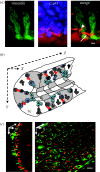Physiological and physiopathological aspects of connexins and communicating gap junctions in spermatogenesis
- PMID: 20403873
- PMCID: PMC2871914
- DOI: 10.1098/rstb.2009.0114
Physiological and physiopathological aspects of connexins and communicating gap junctions in spermatogenesis
Abstract
Spermatogenesis is a highly regulated process of germ cell proliferation and differentiation, starting from spermatogonia to spermatocytes and giving rise to spermatids, the future spermatozoa. In addition to endocrine regulation, testicular cell-cell interactions are essential for spermatogenesis. This precise control is mediated through paracrine/autocrine pathways, direct intercellular contacts and through intercellular communication channels, consisting of gap junctions and their constitutive proteins, the connexins. Gap junctions are localized between adjacent Leydig cells, between Sertoli cells and between Sertoli cells and specific germ cells. This review focuses on the distribution of connexins within the seminiferous epithelium, their participation in gap junction channel formation, the control of their expression and the physiological relevance of these junctions in both the Sertoli-Sertoli cell functional synchronization and the Sertoli-germ cell dialogue. In this review, we also discuss the potential implication of disrupted connexin in testis cancer, since impaired expression of connexin has been described as a typical feature of tumoral proliferation.
Figures



References
-
- Altay B., Turna B., Oktem G., Aktuğ H., Semerci B., Bilir A.2008Immunohistochemical expression of connexin 43 and occludin in the rat testis after epididymal and vasal ligation. Fertil. Steril. 90, 141–147 (doi:10.1016/j.fertnstert.2007.05.065) - DOI - PubMed
-
- Amjad A. I., Söder O., Sultana T.2006Role of testicular interleukin-1alpha IL-1alpha in testicular physiology and disease. J. Coll. Physicians Surg. Pak. 16, 55–60 - PubMed
-
- Aravindakshan J., Cyr D. G.2005Nonylphenol alters connexin43 levels and connexin43 phosphorylation via an inhibition of the p38-mitogen-activated protein kinase pathway. Biol. Reprod. 72, 1232–1240 (doi:10.1095/biolreprod.104.038596) - DOI - PubMed
-
- Aravindakshan J. M., Gregory M., Marcogliese D. J., Fournier M., Cyr D. G.2004Consumption of xenoestrogen-contaminated fish during lactation alters adult male reproductive function. Toxicol. Sci. 81, 179–189 (doi:10.1093/toxsci/kfh174) - DOI - PubMed
-
- Baranova A., et al. 2004The mammalian pannexin family is homologous to the invertebrate innexin gap junction proteins. Genomics 83, 706–716 (doi:10.1016/j.ygeno.2003.09.025) - DOI - PubMed
Publication types
MeSH terms
Substances
LinkOut - more resources
Full Text Sources
Miscellaneous
